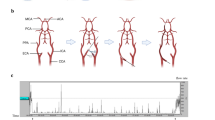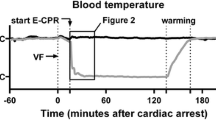Abstract
Two previous clinical trials investigating hypothermia as an adjunct therapy for myocardial infarction have failed. Recently a pilot study has demonstrated a significant reduction in infarct size. The aims of this study were to elucidate the effects of hypothermia on reperfusion injury and to investigate the optimal hypothermia protocol for a future clinical trial. Pigs (40–50 kg) were anesthetized and a normal pig temperature of 38°C was established utilizing an endovascular temperature modulating catheter. The pigs were randomized to a combination hypothermia group (1,000 ml of 4°C saline solution and endovascular cooling, n = 8), or to normothermic controls (n = 8). A PCI balloon was then inflated in the LAD for 40 min (control) or 45 min with hypothermia induced during the last 5 min. Furthermore, hypothermia induced by cold saline alone (n = 8), and prolonged combination hypothermia during reperfusion (n = 7) were also examined. Infarct size and area at risk were determined ex vivo after 4 h of reperfusion using gadolinium-enhanced MRI and Tc-99-tetrofosmin SPECT, respectively. All pigs in the combination hypothermia group were cooled to <35°C within 5 min. Combination hypothermia reduced IS/AAR by 18% compared with normothermic controls despite 5 min longer ischemic time (61 ± 5 vs. 74 ± 4%, p = 0.03). Cold saline did not reduce IS/AAR. Prolonging hypothermia treatment after onset of reperfusion by an additional 45 min over that used in a previous paper did not confer any additional benefit. The cardioprotective effects of hypothermia treatment are due to an attenuation of myocardial injury during both ischemia and reperfusion. The results suggest that a hypothermia protocol using a cold saline infusion and endovascular cooling enables hypothermia to be induced in a clinical setting without delaying reperfusion therapy.




Similar content being viewed by others
Abbreviations
- AAR:
-
Area at risk
- ECG:
-
Electrocardiography
- IS:
-
Infarct size
- SPECT:
-
Single photon emission computed tomography
- MRI:
-
Magnetic resonance imaging
- LAD:
-
Left anterior descending coronary artery
- PCI:
-
Percutaneous coronary intervention
- MO:
-
Microvascular obstruction
References
Ambrosio G, Tritto II (1997) Lethal myocardial reperfusion injury: does it exist, should we treat it? J Thromb Thrombolysis 4:69–70
Badeer H (1956) Effect of hypothermia on oxygen consumption and energy utilization of heart. Circ Res 4:523–526
Becker LB (2010) Does cool reperfusion limit myocardial infarction injury? Circ Cardiovasc Interv 3:397–399. doi:10.1161/CIRCINTERVENTIONS.110.958546
Choi CJ, Haji-Momenian S, Dimaria JM, Epstein FH, Bove CM, Rogers WJ, Kramer CM (2004) Infarct involution and improved function during healing of acute myocardial infarction: The role of microvascular obstruction. J Cardiovasc Magn Reson 6:917–925
Dae MW, Gao DW, Sessler DI, Chair K, Stillson CA (2002) Effect of endovascular cooling on myocardial temperature, infarct size, and cardiac output in human-sized pigs. Am J Physiol Heart Circ Physiol 282:H1584–H1591. doi:10.1152/ajpheart.00980.2001
Dixon SR, Whitbourn RJ, Dae MW, Grube E, Sherman W, Schaer GL, Jenkins JS, Baim DS, Gibbons RJ, Kuntz RE, Popma JJ, Nguyen TT, O’Neill WW (2002) Induction of mild systemic hypothermia with endovascular cooling during primary percutaneous coronary intervention for acute myocardial infarction. J Am Coll Cardiol 40:1928–1934 S0735109702025676[pii]
Duncker DJ, Klassen CL, Ishibashi Y, Herrlinger SH, Pavek TJ, Bache RJ (1996) Effect of temperature on myocardial infarction in swine. Am J Physiol 270:H1189–H1199
Gotberg M, Olivecrona GK, Engblom H, Ugander M, van der Pals J, Heiberg E, Arheden H, Erlinge D (2008) Rapid short-duration hypothermia with cold saline and endovascular cooling before reperfusion reduces microvascular obstruction and myocardial infarct size. BMC cardiovascular disorders 8:7. doi:10.1186/1471-2261-8-7
Gotberg M, Olivecrona GK, Koul S, Carlsson M, Engblom H, Ugander M, van der Pals J, Algotsson L, Arheden H, Erlinge D (2010) A pilot study of rapid cooling by cold saline and endovascular cooling before reperfusion in patients with ST-elevation myocardial infarction. Circ Cardiovasc Interv 3:400–407. doi:10.1161/CIRCINTERVENTIONS.110.957902
Gotberg M, van der Pals J, Olivecrona GK, Koul S, Erlinge D (2010) Mild hypothermia reduces acute mortality and improves hemodynamic outcome in a cardiogenic shock pig model. Resuscitation 81:1190–1196. doi:10.1016/j.resuscitation.2010.04.033
Hale SL, Dae MW, Kloner RA (2003) Hypothermia during reperfusion limits ‘no-reflow’ injury in a rabbit model of acute myocardial infarction. Cardiovasc Res 59:715–722 S0008636303004565[pii]
Hale SL, Dave RH, Kloner RA (1997) Regional hypothermia reduces myocardial necrosis even when instituted after the onset of ischemia. Basic Res Cardiol 92:351–357
Hale SL, Kloner RA (1999) Ischemic preconditioning and myocardial hypothermia in rabbits with prolonged coronary artery occlusion. Am J Physiol 276:H2029–H2034
Hale SL, Kloner RA (1997) Myocardial temperature in acute myocardial infarction: protection with mild regional hypothermia. Am J Physiol 273:H220–H227
Hausenloy DJ, Baxter G, Bell R, Botker HE, Davidson SM, Downey J, Heusch G, Kitakaze M, Lecour S, Mentzer R, Mocanu MM, Ovize M, Schulz R, Shannon R, Walker M, Walkinshaw G, Yellon DM (2010) Translating novel strategies for cardioprotection: the hatter workshop recommendations. Basic Res Cardiol 105:677–686. doi:10.1007/s00395-010-0121-4
Hearse DJ, Humphrey SM, Chain EB (1973) Abrupt reoxygenation of the potassium-arrested perfused rat heart: a study of myocardial enzyme release. J Mol Cell Cardiol 5:395–407
Hedstrom E, Engblom H, Frogner F, Astrom-Olsson K, Ohlin H, Jovinge S, Arheden H (2009) Infarct evolution in man studied in patients with first-time coronary occlusion in comparison to different species—implications for assessment of myocardial salvage. J Cardiovasc Magn Reson 11:38. doi:10.1186/1532-429X-11-38
Heiberg E, Sjogren J, Ugander M, Carlsson M, Engblom H, Arheden H (2010) Design and validation of segment—freely available software for cardiovascular image analysis. BMC Med Imaging 10:1. doi:10.1186/1471-2342-10-1
Heiberg E, Ugander M, Engblom H, Gotberg M, Olivecrona GK, Erlinge D, Arheden H (2008) Automated quantification of myocardial infarction from MR images by accounting for partial volume effects: animal, phantom, and human study. Radiology 246:581–588. doi:10.1148/radiol.2461062164
Heusch G (2004) Postconditioning: old wine in a new bottle? J Am Coll Cardiol 44:1111–1112. doi:10.1016/j.jacc.2004.06.013
Heusch G, Boengler K, Schulz R (2008) Cardioprotection: nitric oxide, protein kinases, and mitochondria. Circulation 118:1915–1919. doi:10.1161/CIRCULATIONAHA.108.805242
Heusch G, Kleinbongard P, Bose D, Levkau B, Haude M, Schulz R, Erbel R (2009) Coronary microembolization: from bedside to bench and back to bedside. Circulation 120:1822–1836. doi:10.1161/CIRCULATIONAHA.109.888784
Heusch G, Skyschally A, Schulz R (2011) The in situ pig heart with regional ischemia/reperfusion—ready for translation. J Mol Cell Cardiol 50:951–963. doi:10.1016/j.yjmcc.2011.02.016
Kim RJ, Fieno DS, Parrish TB, Harris K, Chen EL, Simonetti O, Bundy J, Finn JP, Klocke FJ, Judd RM (1999) Relationship of MRI delayed contrast enhancement to irreversible injury, infarct age, and contractile function. Circulation 100:1992–2002
Klein HH, Schubothe M, Nebendahl K, Kreuzer H (1984) Temporal and spatial development of infarcts in porcine hearts. Basic Res Cardiol 79:440–447
Lima JA, Judd RM, Bazille A, Schulman SP, Atalar E, Zerhouni EA (1995) Regional heterogeneity of human myocardial infarcts demonstrated by contrast-enhanced MRI. Potential mechanisms. Circulation 92:1117–1125
Maeng M, Mortensen UM, Kristensen J, Kristiansen SB, Andersen HR (2006) Hypothermia during reperfusion does not reduce myocardial infarct size in pigs. Basic Res Cardiol 101:61–68. doi:10.1007/s00395-005-0550-7
Miki T, Liu GS, Cohen MV, Downey JM (1998) Mild hypothermia reduces infarct size in the beating rabbit heart: a practical intervention for acute myocardial infarction? Basic Res Cardiol 93:372–383
Miura T, Miki T (2008) Limitation of myocardial infarct size in the clinical setting: current status and challenges in translating animal experiments into clinical therapy. Basic Res Cardiol 103:501–513. doi:10.1007/s00395-008-0743-y
Musiolik J, van Caster P, Skyschally A, Boengler K, Gres P, Schulz R, Heusch G (2010) Reduction of infarct size by gentle reperfusion without activation of reperfusion injury salvage kinases in pigs. Cardiovasc Res 85:110–117. doi:10.1093/cvr/cvp271
Ohta S, Yukioka T, Wada T, Miyagatani Y, Matsuda H, Shimazaki S (1995) Effect of mild hypothermia on the coefficient of oxygen delivery in hypoxemic dogs. J Appl Physiol 78:2095–2099
Ovize M, Baxter GF, Di Lisa F, Ferdinandy P, Garcia-Dorado D, Hausenloy DJ, Heusch G, Vinten-Johansen J, Yellon DM, Schulz R (2010) Postconditioning and protection from reperfusion injury: where do we stand? Position paper from the Working Group of Cellular Biology of the Heart of the European Society of Cardiology. Cardiovasc Res 87:406–423. doi:10.1093/cvr/cvq129
Piot C, Croisille P, Staat P, Thibault H, Rioufol G, Mewton N, Elbelghiti R, Cung TT, Bonnefoy E, Angoulvant D, Macia C, Raczka F, Sportouch C, Gahide G, Finet G, Andre-Fouet X, Revel D, Kirkorian G, Monassier JP, Derumeaux G, Ovize M (2008) Effect of cyclosporine on reperfusion injury in acute myocardial infarction. N Engl J Med 359:473–481. doi:10.1056/NEJMoa071142
Polderman KH (2009) Mechanisms of action, physiological effects, and complications of hypothermia. Crit Care Med 37:S186–S202. doi:10.1097/CCM.0b013e3181aa5241
Shao ZH, Sharp WW, Wojcik KR, Li CQ, Han M, Chang WT, Ramachandran S, Li J, Hamann KJ, Vanden Hoek TL (2010) Therapeutic hypothermia cardioprotection via Akt- and nitric oxide-mediated attenuation of mitochondrial oxidants. Am J Physiol Heart Circ Physiol 298:H2164–H2173. doi:10.1152/ajpheart.00994.2009
Skyschally A, Schulz R, Heusch G (2010) Cyclosporine A at reperfusion reduces infarct size in pigs. Cardiovasc Drugs Ther 24:85–87. doi:10.1007/s10557-010-6219-y
Skyschally A, van Caster P, Iliodromitis EK, Schulz R, Kremastinos DT, Heusch G (2009) Ischemic postconditioning: experimental models and protocol algorithms. Basic Res Cardiol 104:469–483. doi:10.1007/s00395-009-0040-4
Thibault H, Piot C, Staat P, Bontemps L, Sportouch C, Rioufol G, Tri Cung T, Bonnefoy E, Angoulvant D, Aupetit J-F, Finet G, Andre-Fouet X, Macia C, Raczka F, Rossi R, Itti R, Kirkorian G, Derumeaux G, Ovize M (2008) Long-term benefit of postconditioning. Circulation 117:1037–1044. doi:10.1161/CIRCULATIONAHA.107.729780
Tissier R, Hamanaka K, Kuno A, Parker JC, Cohen MV, Downey JM (2007) Total liquid ventilation provides ultra-fast cardioprotective cooling. J Am Coll Cardiol 49:601–605. doi:10.1016/j.jacc.2006.09.041
Wu KC, Zerhouni EA, Judd RM, Lugo-Olivieri CH, Barouch LA, Schulman SP, Blumenthal RS, Lima JA (1998) Prognostic significance of microvascular obstruction by magnetic resonance imaging in patients with acute myocardial infarction. Circulation 97:765–772
Yang X, Liu Y, Yang XM, Hu F, Cui L, Swingle MR, Honkanen RE, Soltani P, Tissier R, Cohen MV, Downey JM (2011) Cardioprotection by mild hypothermia during ischemia involves preservation of ERK activity. Basic Res Cardiol 106:421–430. doi:10.1007/s00395-011-0165-0
Zhao ZQ, Corvera JS, Halkos ME, Kerendi F, Wang NP, Guyton RA, Vinten-Johansen J (2003) Inhibition of myocardial injury by ischemic postconditioning during reperfusion: comparison with ischemic preconditioning. Am J Physiol Heart Circ Physiol 285:H579–H588. doi:10.1152/ajpheart.01064.2002
Acknowledgments
We would like to thank Boston Scientific Cardiology, Nordic AB (Helsingborg, Sweden) for their generosity in unrestricted donations of catheters and guide wires for use in animal research and Philips Innercool therapies Inc, San Diego, CA, USA for an unrestricted loan of the Celsius Control™ cooling console. This work was supported by the Swedish Research Council (VR 521-2009-2276), the Swedish Heart and Lung Foundation and the Vascular Wall program (Lund University Faculty of Medicine). David Erlinge is a holder of the Lars Werkö distinguished research fellowship from the Swedish Heart and Lung Foundation.
Conflict of interest
None declared.
Author information
Authors and Affiliations
Corresponding author
Rights and permissions
About this article
Cite this article
Götberg, M., van der Pals, J., Götberg, M. et al. Optimal timing of hypothermia in relation to myocardial reperfusion. Basic Res Cardiol 106, 697–708 (2011). https://doi.org/10.1007/s00395-011-0195-7
Received:
Revised:
Accepted:
Published:
Issue Date:
DOI: https://doi.org/10.1007/s00395-011-0195-7




